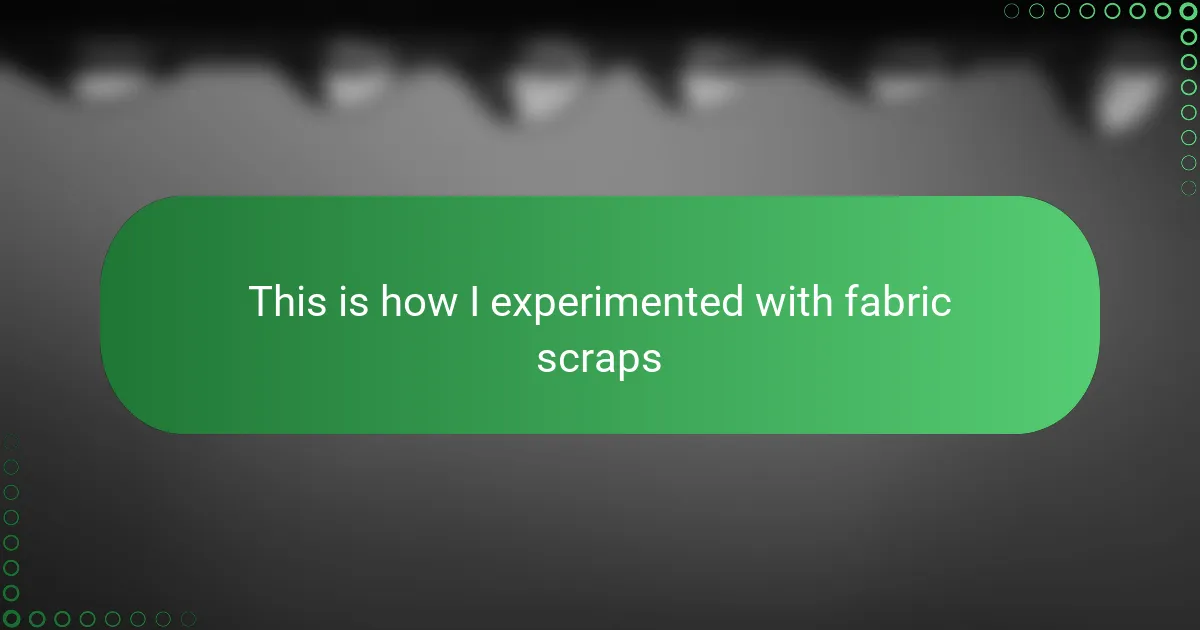Key takeaways
- Handmade paper crafting combines tradition and innovation, showcasing the unique character of each piece.
- Different fabric scraps, such as cotton, linen, and silk, significantly affect the texture and durability of the final paper product.
- Proper preparation of fabric, including cleaning and cutting, enhances the quality of the paper and ensures a smoother crafting experience.
- Creative uses for fabric scrap paper include making gift tags, bookmarks, and handmade cards, adding a personal touch to creations.

Introduction to Handmade Paper Crafts
Handmade paper crafts have always fascinated me for their unique blend of creativity and patience. There’s something deeply satisfying about transforming simple pulp into textured sheets that feel alive with character. Have you ever wondered how ordinary materials can become a canvas for endless artistic expression?
Working with handmade paper is like embarking on a tactile journey; each sheet carries subtle imperfections that tell a story. I often find myself caught in the quiet magic of layering fibers, knowing that no two pieces will ever be exactly the same. This unpredictability keeps me hooked, inviting me to experiment and push boundaries with every project.
What truly draws people to handmade paper crafts, in my experience, is the connection to tradition combined with the freedom to innovate. The tactile sensation, the smell of raw materials, and the visual texture all come together in a way that machine-made paper simply can’t replicate. Isn’t it remarkable how such a humble craft can ignite such passion?
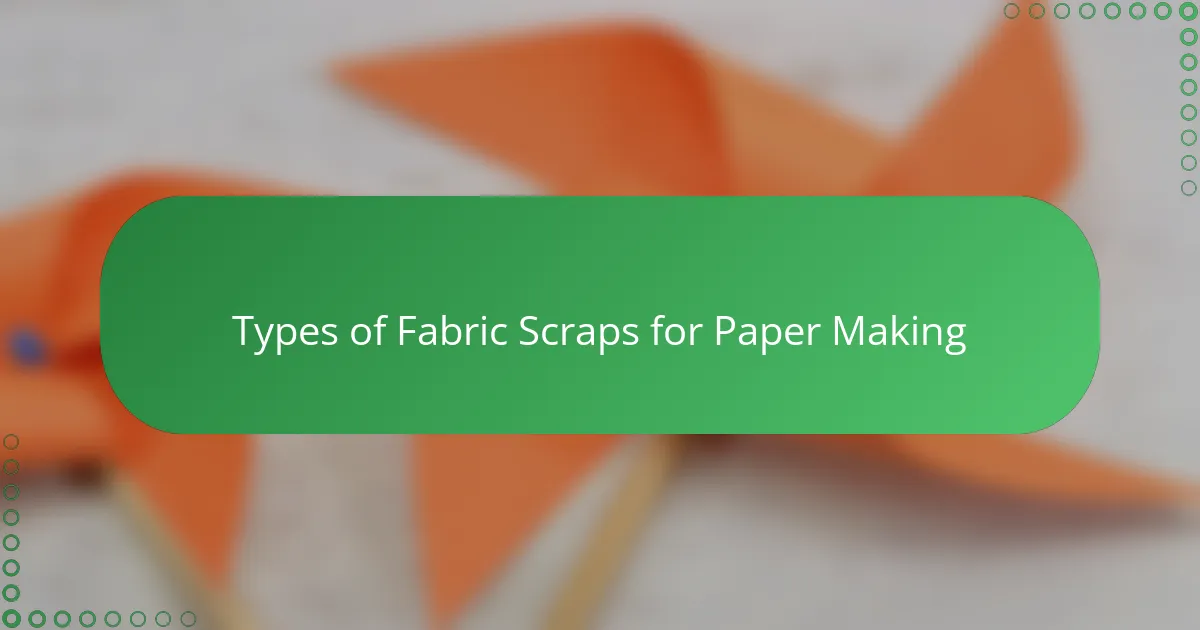
Types of Fabric Scraps for Paper Making
When I first started experimenting with fabric scraps in paper making, I quickly realized that the type of fabric dramatically changes the outcome. Cotton scraps, for example, blend beautifully into the pulp, giving the paper a soft, smooth texture that feels almost like cloth itself. Have you ever noticed how the natural fibers seem to whisper their history into the paper, adding warmth and depth?
On the other hand, I found linen scraps bring a lovely strength and durability to the sheets, which surprised me. The coarser weave doesn’t fully dissolve, leaving behind interesting textures that invite touch and closer inspection. It’s like the fabric leaves its fingerprint—unique and unmistakable—in every piece.
Then there are silk scraps, which I admit felt a bit like working with magic. Their fine threads create a subtle sheen that dances with light, transforming what could be a simple sheet of paper into something almost luminous. It made me wonder: can paper ever feel truly ordinary when it carries such unexpected beauty from its fabric origins?

Preparing Fabric Scraps for Crafting
Before diving into crafting, I always make sure to clean and sort my fabric scraps thoroughly. Removing any dirt, stains, or unwanted threads is essential because even small impurities can affect how the fibers blend into the pulp. Have you ever noticed how a tiny stray thread can disrupt the smoothness of your paper? I’ve learned firsthand that taking the time to prepare fabric properly makes a world of difference.
Cutting the scraps into small, manageable pieces is another step I never skip. Smaller fragments break down more easily during the pulping process, which helps achieve an even texture in the final sheet. When I first ignored this, my paper had annoying clumps that stuck out—lesson learned! It’s such a simple adjustment that improves the entire crafting experience.
Sometimes, I soak the fabric pieces overnight to soften them further before processing. This trick, I discovered quite accidentally, really helps the fibers separate and mingle better with the paper pulp. I wonder if others have tried this—because to me, that extra patience feels like a secret ingredient that elevates the craft to another level.
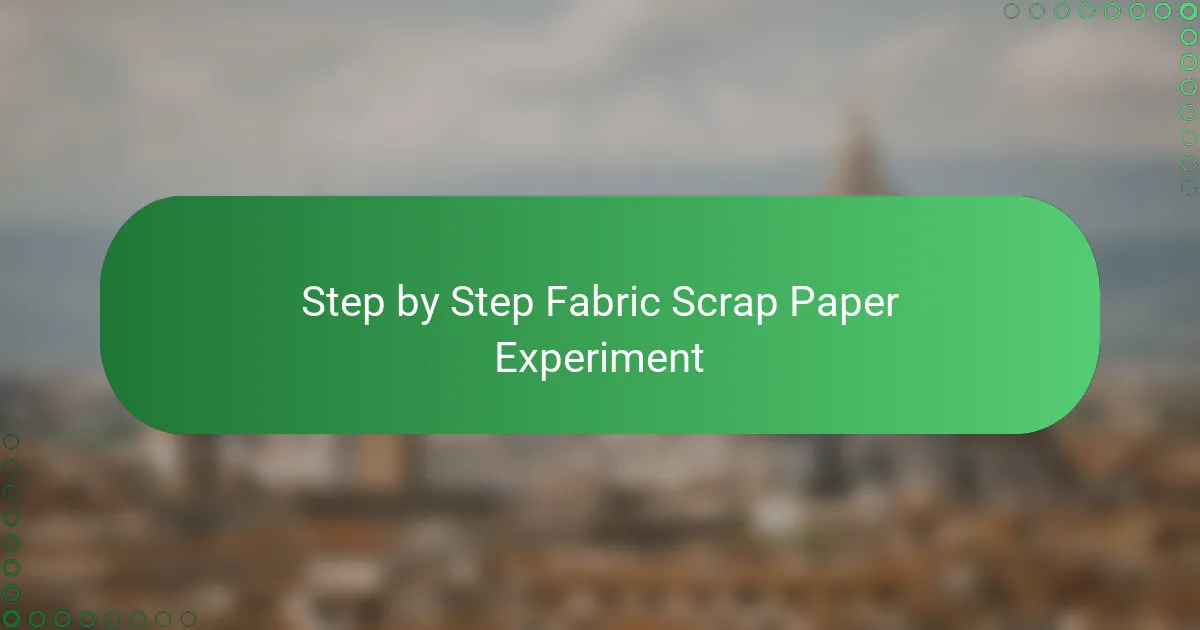
Step by Step Fabric Scrap Paper Experiment
Starting the experiment, I shredded the prepared fabric scraps into tiny bits and mixed them gently into the paper pulp. It surprised me how quickly the colors and textures began to blend, almost like watching a slow-motion dance of fibers coming together. Have you ever felt that moment when your materials suddenly start to transform, and you realize the magic is truly happening?
Next, I carefully spread the mixture onto a screen mold, trying to keep the layer even but flexible enough to reveal the fabric’s character beneath. I remember nervously lifting the screen for the first time, holding my breath to see if the fibers had bonded just right. That delicate balance between control and unpredictability is what makes this process so thrilling, don’t you think?
Once dry, peeling the paper off revealed surprising textures and color patterns that I hadn’t fully anticipated. Some areas showed soft, almost velvety patches, while others held tiny loops and threads poking through like hidden treasures. This step reminded me why I keep experimenting—every sheet tells a story, and with fabric scraps, those stories become so wonderfully tactile and alive.
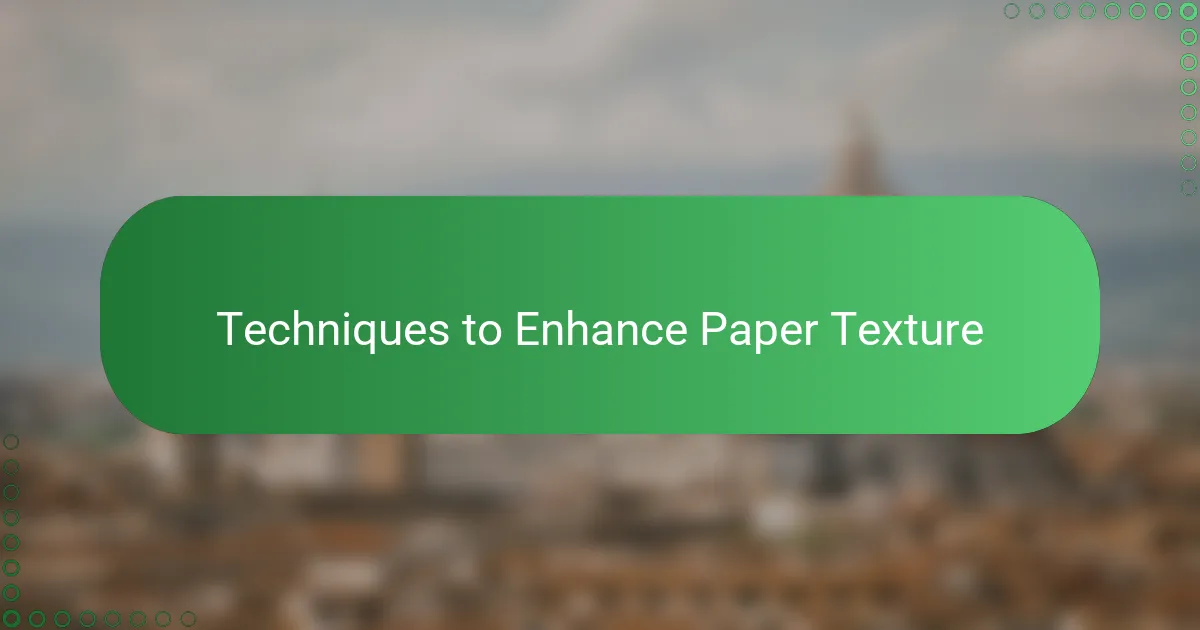
Techniques to Enhance Paper Texture
Whenever I want to deepen the texture of my handmade paper, I reach for techniques like layering fibers or embedding fabric fragments right into the pulp. I’ve noticed that gently pressing or folding the wet sheets can create subtle ridges and patterns that invite touch—almost like whispering secrets through the paper’s surface. Have you ever felt the thrill of running your fingers over a sheet that feels both delicate and alive?
Adding textured elements, like coarse fabric threads or even tiny pieces of lace, can transform a flat paper sheet into something much more engaging. Early on, I tried sprinkling small scraps on just after laying down the pulp, and the uneven, tactile surface that emerged was unlike anything I expected. It made me realize texture isn’t just seen; it’s experienced, almost like the paper has its own voice.
Sometimes, I experiment with tools—like using brushes or combs on the damp pulp—to carve fine lines or waves before the paper dries. It’s surprising how these simple gestures can shift the whole mood of a sheet, turning it from ordinary into something truly expressive. Have you tried this kind of playful manipulation? For me, it feels like collaborating with the paper rather than just making it.
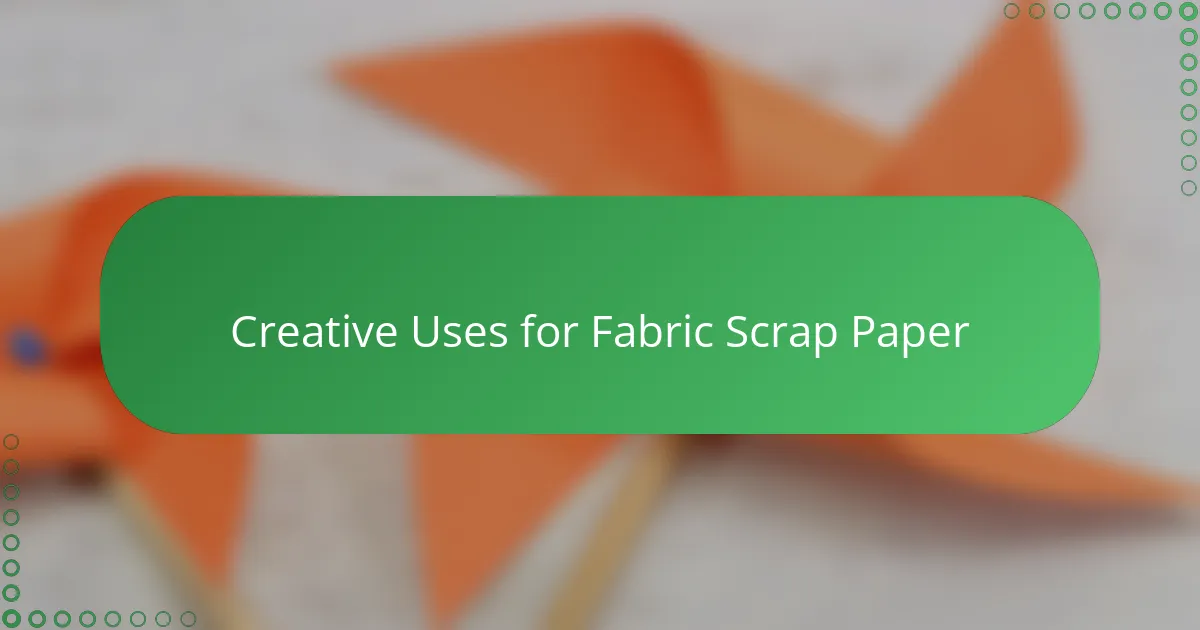
Creative Uses for Fabric Scrap Paper
One of the most exciting discoveries I made was using fabric scrap paper as unique gift tags and bookmarks. The textured surface adds a tactile charm that regular paper just can’t match. Have you ever handed someone a gift and seen their face light up because of a small, unexpected detail like that? For me, it’s a simple way to share the love and craft all at once.
I also love creating collage art with fabric scrap paper. Tearing and layering pieces lets me play with color and texture in ways that feel fresh and spontaneous. Sometimes, the scraps don’t behave as I expect—they fold or catch the light differently—making each collage a little adventure in creativity. Isn’t it fascinating how something as humble as leftover fabric can become the centerpiece of a vibrant artwork?
Another fun use I stumbled upon was making handmade cards with embedded fabric scrap accents. Just pressing a small snippet into the wet pulp gives the paper subtle depth and character. I remember the first time I did this; the card felt alive, almost like it was whispering its story before I’d even written a word. Have you tried adding your own fabric touches to paper crafts? It’s a simple trick, but one that truly elevates the finished piece.
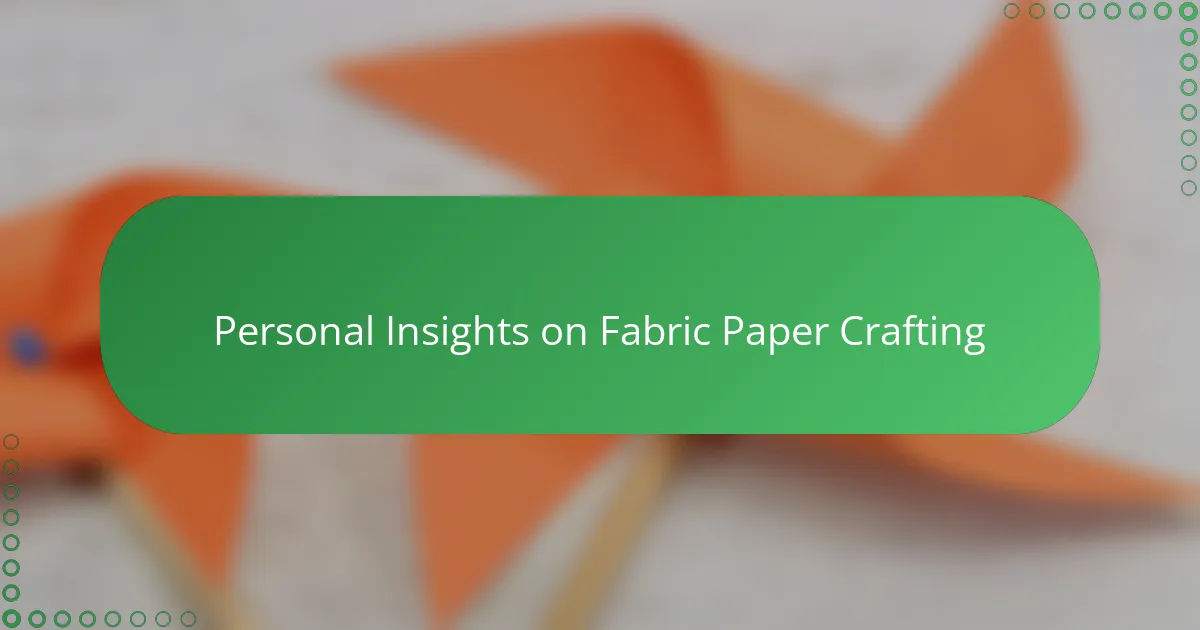
Personal Insights on Fabric Paper Crafting
When I first mixed fabric scraps into my paper pulp, I was amazed at how the fibers didn’t just blend—they seemed to bring a personality of their own. Have you ever felt that moment when something unexpectedly personal emerges from a simple craft? For me, fabric scrap paper crafting became less about perfect results and more about embracing those little quirks and surprises.
There’s something deeply satisfying about seeing how different fabrics interact with the pulp—how cotton softens the feel or how linen adds strength. Each experiment felt like a conversation between materials, where I learned to listen closely and respond with gentle adjustments. It made me realize crafting isn’t just a task; it’s an ongoing discovery, full of tactile emotions and creative play.
Sometimes, I get lost in the textures and colors, almost forgetting the time as I fold or press the wet paper sheets, wondering how the fabric scraps will reveal themselves once dry. Isn’t it fascinating how working with these humble bits can unlock such a rich world of textures and stories? This part of the process is where crafting truly feels alive and deeply personal to me.
